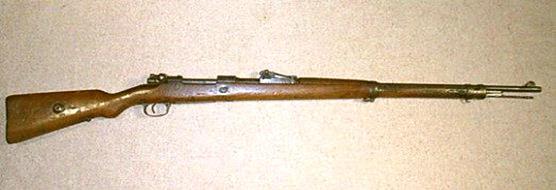

|
A TRIBUTE: General Jozef Haller & The Blue Army
|
|
Home |
|
About General Haller |
|
The Blue Army |
|
Artifacts |
|
Portrait Gallery |
|
The Riflemen's Assoc. |
|
Bibliography |
|
Campaign Maps |
|
Haller's Army Video |
|
Real Audio Clips |
|
Help Build This Page |
|
About Us |

|
The Guns of Haller’s Army
by Bob Tarwacki |
|
“...the size of the Polish Army was not a true indication of its efficiency. It was burdened with enormous defects, which would take a great deal of time to remedy. The greatest problem was in logistics. A single Polish division might be equipped with four different rifles – the French Lebel, the Austrian Mannlicher, the Russian Berdan and the German Mauser. Each of these used a different ammunition, a matter that created endless resupply problems.”
(An excerpt from page 114 of “Bitter Glory” by Richard M. Watt) |

|
French Model 1886 Rifle “Lebel” |
|
The M1886 (Commonly Called the Lebel) |
|
“This rifle was introduced in 1886 to use a new 8mm cartridge loaded with the then revolutionary smokeless powder of Paul Vielle. The Lebel bolt action is quite similar to that of the 11mm Gras rifle Model 1874, and the feed mechanism is similar to the 11mm Model 1878 Kropatschek rifle used by the French Navy. The M1886 is the parent of all modern small-bore military rifles. It was slightly modified in 1893 by strengthening the receiver, boring a gas-escape hole in the bolt, changing the rear sight mounting and leaf, and adding a stacking hook to the upper band. It was still in limited service in World War II, while numerous modified rifles were built around many spare parts of the old 86/93.
This is a turn-bolt action rifle of conventional design. The magazine is a tube in the forestock below the barrel, being loaded through the open bolt action. The bolt is a two piece design with a long detachable bolt head, which carries the dual locking lugs. To remove the bolt, the action must be opened. A holding screw is then removed from a projecting strap on the top of the bolt body. The bolt body can them be pulled out of the receiver, leaving the bolt head in the boltway. Primary extraction is given as the bolt handle is lifted by the projecting bolt strap working against a cam face in a long overhang on the top of the receiver. As the bolt is withdrawn, it operates an elevator, which raises a cartridge in its trough and lines it up with the bolt. A hook on the bottom of the elevator trough blocks the cartridge in the magazine tube at this point. When the cartridge is chambered, the bolt motion lowers the elevator trough, permitting the magazine spring in the tube to force the next cartridge into the trough ready to be raised on the following rearward bolt stroke.”
(Excerpted from “Small Arms of the World” by E. Ezell) |

|
The “Lebel” operating system – Cutaway view |
|
Austrian Mannlicher 8mm Rifle Model 1888 |

|
Austrian Mannlicher 8mm Rifle Model 1895 |

|
(Repetier Gewehr M95) |
|
This weapon, which was made at Budapest as well as Steyr, was the principal Austro-Hungarian rifle of World War I. The M95 rifle was made in tremendous quantities. |
|
German Mauser 7.92mm Model 88 |

|
German Mauser 7.92mm Model 98 |

|
(Gewehr 98) |
|
The rifle 98 (Gewehr 98), introduced in 1898, is the most successful bolt-action design ever produced. In one form or another, the 98 action has been used by most of the countries of the world since 1898. The rifle was the principal rifle of the German Army in World War I, and a number of variations of the rifle appeared during that war. |
|
Russian Berdan |

|
(Russian Berdan II) |
|
The Russian Berdans, the M1868 Russian Berdan I and the M1870 Russian Berdan II rifles, were designed by General Hiram Berdan. This rifle is a bolt action pattern with a comparatively small bolt which acts as the rifle's sole locking lug, locking against the split bridge receiver. It fired a 10.66mm Berdan primed cartridge. The sights are graduated in Russian arshin. |